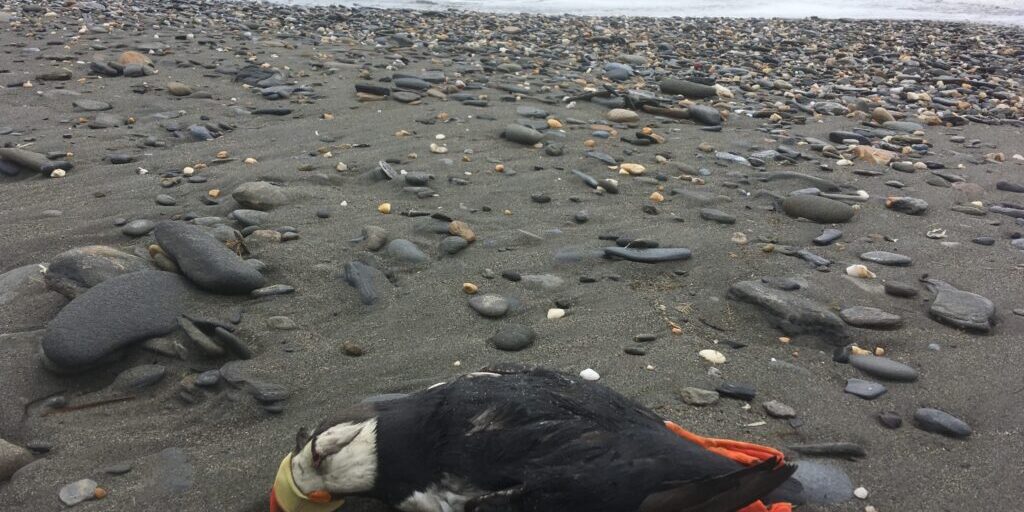Reports of dead seabirds found on the shores of Western Alaska are being documented again this summer. According to local experts this would mark the fourth year in a row the Bering Strait region has seen a seabird die-off, if the number of bird casualties continue to rise.
Brandon Ahmasuk, Kawerak’s Vice President of Natural Resources, says for the region to see large numbers of dead seabirds for this many years is concerning.
“Like you mentioned, the last four years, maybe five now…the amount [of dead seabirds] that we’ve been getting is alarming.”
– Brandon Ahmasuk
The latest reports of dead seabirds in the Bering Strait region came from Nome, within the last couple weeks. Robb Kaler with the U.S. Fish and Wildlife Service (USFWS), says the first report from the region this summer was for a dead murre found in Nome around June 2nd.
“That was a little bit later fortunately then we’ve been getting reports from Gay [Sheffield] from the Bering Strait region for the previous two or three years, so we were hopeful that maybe it wasn’t going to be another die-off year, but…”
But alas, the reports and observations are increasingly pointing to a seabird die-off in the Bering Strait region. This would be the fourth consecutive die-off for the region, although it’s been six years in a row that large scale seabird die-offs have occurred in Alaskan waters.
According to Kaler, the majority of the roughly 50 deceased birds reported last month were either murres or horned puffins. Most of them came from Nome while a couple were found in Shishmaref and on St. Lawrence Island.
And then, within the first two weeks of July, Gay Sheffield of Alaska Sea Grant said she received reports of an additional 60 dead seabirds. So far, initial test results from a handful of those birds have indicated that all of them were emaciated.
But, as Sheffield explains, the unanswered question remains: why were these birds and the hundreds from previous years, starving to death?
“So you have a skinny bird starving. That bird could either not find food, even though he’s healthy and looking for food; or he could be sick with something and not feel like eating. Those are two different avenues. If you start looking at starvation, you really want to know whether it’s a lack of food or if there’s an overlying problem.”
Since residents and scientists are finding multiple species of birds washing up dead in the region, Sheffield says she tends to think that indicates a larger scale issue going on in the Bering Sea ecosystem.

But, scientists with USFWS and the U.S. Geological Survey (USGS) are still conducting their tests on the seabird carcasses to try to answer that question. Kaler says they are testing for a host of things like infectious diseases such as Avian flu, as well as biotoxins from Harmful Algal Blooms. So far infectious disease seems to have been ruled out for these particular seabirds.
Meanwhile residents of the Bering Strait region continue to rely on the birds and their eggs for subsistence. Ahmasuk says it appears that less harvesting is happening this year.
“So normally my family will go out to Sledge Island and get a cooler full of murre eggs. And I think this year my brother got one…Other communities, like Diomede, had very little egg harvest…So when you combine those two things and think about how that affects everything, then it gets scary.”
The hope was that this summer was going to be an opportunity to shed some light on this mysterious series of die-offs, but now, due to the coronavirus pandemic, essentially no outside research vessels will be coming to the region to study the large-scale ecosystem-wide changes.
Sheffield says despite this survey setback, the Bering Strait region won’t be left floundering.
“Lack of scientific data in a region does not mean there’s a lack of knowledge. Our communities in the Bering Strait region utilize the seabirds every year, spring and fall, for food…When people are calling in with information that is not normal, that is immediately a highlight to me that we need to get an answer.”
While the region awaits more test results and answers from the federal agencies, Sheffield encourages Bering Strait residents to report any dead seabirds or unusual observations they find this summer.
You can send your photos or reports to Brandon Ahmasuk at Kawerak by calling 443-4265 or Gay Sheffield at Alaska Sea Grant by calling 434-1149. To report dead seabirds with USFWS, call their hotline: 1-866-527-3358.
Image at top: A dead Puffin found along one of the beaches of Nome in June, 2020. Photo from Gay Sheffield, used with permission.




